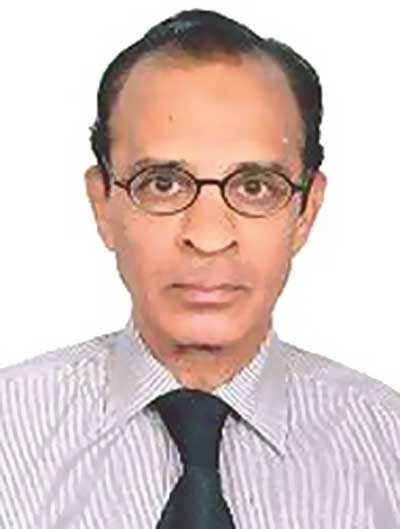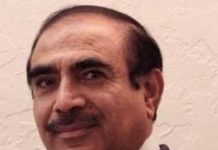Supporters cheer Sheikh Mujeebur Rahman at liberation. On December 16, 1971, Pakistani troops laid down their arms and surrendered to India for the secession of East Pakistan. The lives of hundreds of thousands of innocent civilians were lost. Much has been written about this watershed in Pakistan’s history. For the younger generation, it is recommending Brigadier Siddique Salik’s book Main Ne Dacca Doobtey Dekha which throws ample light on the subject and is worth reading. I simply believe, though, that we should remember this day to pay homage to the patriots who gave their lives for Pakistan so that we can learn lessons from the events that occurred in the past in order to avoid any such recurrence in the future. So to commemorate, in a way of speaking, the ’48th death anniversary’ of East Pakistan, I would like to recount here some of the events that I, as a resident of Dhaka, witnessed.
My parents migrated from the Indian province of Bihar to East Pakistan in 1947. I was born and bred in Dacca, as it was formerly called, the capital of East Pakistan. My father was an employee of Pakistan Postal Service. The Post and Telegraph (P&T) colony, where we lived, consisted of several three-storied apartment buildings, surrounded by a boundary wall. The demography here was roughly 90 percent Bengali and 10 percent Non-Bengalis, or Biharis as they were usually called. India had set up hundreds of training camps in West Bengal where they trained and armed Bengali youths from East Pakistan to form the Mukti Bahini (Liberation Army). By mid-November 1971, the situation in the border areas had become alarming as more and more Mukti Bahini fighters kept pouring in from Indian Bengal. The border skirmishes were rapidly turning into bloody attacks on Pakistani troops. Eventually, on December 3, 1971, war with India was declared. A survivor of the 1971 civil war recounts the harrowing events of December 16 as a resident in a Bihari locality in Dhaka.
On the morning of December 4, I caught a small group of people looking up at the sky, trembling with excitement. Following their gaze, I lifted my head to scan the sky. After some moments, I caught sight of several white specks moving about in an orderly fashion. Indian planes, MIG-21s and SU-7s, were circling over Dhaka at a very high altitude to avoid ground fire. They tried to bomb Dhaka Airport and the Dhaka Cantonment area but the bombs, dropped from such a great height, went astray and missed their targets. The very next day, the Indian Air Force attacked Dhaka Airport with their full might. Wave after wave of MIGs and Hunters flew over the airport dropping heavy bombs. The Pak gunners on the ground put up a brave fight. They shot down several enemy planes, yet there were so many Indian planes that the airport runway was destroyed, with all the planes standing there.
The war on the ground was being fought in the border areas and towns of Jessore, Khulna, Natore, Kushtia, Rangpur, Dinajpur, Sylhet, etc. Dhaka is situated almost in the middle of the country and is surrounded by the rivers Ganges (Padma), Meghna and Brahamputra. As such, there was no sign of the Mukti Bahini or Indian forces near Dhaka or its adjoining areas. In the city, the only indications of a war being fought were the continuous presence of Indian planes which kept circling high up over the city and the mandatory blackouts at night. Occasionally, from the balcony of our second-floor flat, we could see Indian planes dive and fire rockets at the Governor House. Streaks of fire leaping from the plane would explode over the eastern dome of the Governor House and flames shooting from the ground would explode in the sky as the Pakistan army gunners tried to down these planes. The Governor House was empty as Governor Abdul Malik and his staff had already shifted to the Intercontinental Hotel. The Indian forces had yet to cross the rivers before they could reach Dhaka. This was not easy as the river bridges had been destroyed. The city wore an uneasy calm and the atmosphere was charged with tension. Fear and anxiety was gradually but steadily tightening its grip on the citizen’s .Such was the state of affairs when December 16 dawned over Dhaka.
On that harrowing day, just after Fajr prayers, there was a knock on the door of our flat. I opened the door and saw it was our Bengali neighbour Mallu Bhai. His actual name was Muhammad Ali Khan but everybody affectionately called him by his nickname. He lived with his family in the only other flat on our floor. This handsome man was usually a calm and collected person but today he appeared wildly excited. His eyes were shining, his cheeks were flushed and his voice was loud and shrill. “Imtiaz, have you heard the big new? Akashvani [All Indian Radio] says Pak Army is going to surrender today!”
I laughed loudly (little knowing that this would be my last laugh for a long time), “Oh, come on, Mallu Bhai,” I said, “you know better than to believe Akashvani.”It was late in the evening, nearing dusk, when we heard a loud commotion outside. I rushed to the balcony but what I saw made me freeze with terror. A large unruly mob brandishing bamboo sticks and leather whips was coming down the road to our building. Their faces were distorted with hate and fury. They were in a frenzy, shouting ‘Joy Bangla, kill the Biharis, kill the traitors’. Mallu Bhai replied, “No, you do not understand. This time they have given a [test] as proof to check the veracity of their announcement. They say that our planes will fly low over Dhaka but there will be no fire from the ground. The Pak army’s Ack-Ack [anti-aircraft] guns will stay silent.”
On hearing this, I felt panic rising within me but I controlled myself and said, “Just think, Mallu Bhai, how is this possible? The Indian Army has not reached Dhaka. They are still far away. So then, why should Gen Niazi surrender? And to who is he supposed to surrender?”This repartee dampened Mallu Bhai’s excitement considerably and he went to his home, murmuring, “Ok, we will know the truth in a few hours.”Despite my bravado, I was badly shaken. I went back inside my flat in a state of trepidation. I told my family the news. We kept hoping and praying that it would turn out to be false news. Every now and then, one of us would go to the balcony and scan the sky for Indian planes. And then, what we hoped would not happen, did happen.
The Indian planes came around 10 am. The first few sorties were made at considerable altitude but they soon started to fly lower and lower until we could clearly see the pilots. In stark contrast to previous routine, not a single shot was fired on them from the ground. It was the most bizarre scene. We did not see, as we used to see, flames leaping from the ground to attack these planes. Instead, large numbers of pamphlets were being thrown from the planes. Printed in English, Bengali and Urdu, they invited the public to Ramna Race Course ground in the afternoon to witness the surrender of the Pakistan Army.
Intrigued and hopeful, Bengalis flocked to the race course. There, in the presence of several lakhs of Bengalis raising thunderous slogans of ‘Joy Bangla’ and ‘Jai Hind’, Gen Niazi signed the Instrument of Surrender and handed over his pistol to General Arora Singh. East Pakistan died and Bangladesh was born. At the end of the ceremony, the mammoth crowd that spilled out from the Race Course Ground was on an ecstatic high. The euphoria of freedom kicked in an adrenaline rush, making the crowd boisterous. The cries of ‘Joy Bangla’ were now intermingled with cries of ‘Kill the Pakistanis’. But no one dared to attack the Pakistani troops; most of them were still armed. So, in their murderous mood, the mob spread out in the city to kill and plunder the supporters of Pakistan and the Pakistani army – the Biharis. A strange celebration of independence.
An estimated 300,000 Biharis lived in Dhaka city. They were scattered in various localities of the city, namely Shahjahan Pur, Kamla Pur, Motijheel, Purana Pultan, Nawabpur road, Nawab Bari, Thatheri Bazar, Moulvi Bazar, Armani Tola, Islam Pur, Azim Pur, Saddar Ghat, Eskatan, Dhanmandi, Dhakeshwari, Neel Khet, etc. In all these localities, Biharis were in a minority amounting to five to seven percent of the population.
That night, the Bihari residents of every locality were attacked by the wild mobs that were on a killing, burning and looting spree. To give you a glimpse of the gruesome happenings, I now go back to my flat in P&T Colony, Motijheel. It was late in the evening, nearing dusk, when we heard a loud commotion outside. I rushed to the balcony but what I saw made me freeze with terror. A large unruly mob brandishing bamboo sticks and leather whips was coming down the road to our building. Their faces were distorted with hate and fury. They were in a frenzy, shouting ‘Joy Bangla, kill the Biharis, kill the traitors’. As I looked on, they entered a building that stood very close to the right of ours.
In view of the above article, hopefully the new Government of Bangladesh will do justice to the democratic values and solve the grievances of the students and people of Bangladesh. The present Government says it is working to resolve the attack on minorities especially the Pakistanis (Biharis) as they also have the right to live in dignity. Most of the Pakistanis who are still there should be given equal rights if they have opted to be the citizens of Bangladesh. If they want to leave the country the present government should show some consideration and give them facilities to leave. In return Pakistan should also show good will and allow the Bengalis to go back, if they wish to do so or grant them equal rights if they want to live in Pakistan. The two governments and people of Pakistan and Bangladeshi should live in harmony; have good relationship in order to progress economically. Respect each others’ social and cultural values.
We hope and pray this change of government will be good for the people of Bangladesh and most of the problems will be solved.
To Keep Updated Visit & Follow our Facebook Page Or Our Website





